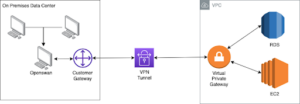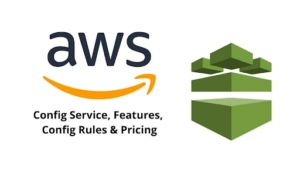Introduction
In the ever-evolving landscape of cloud computing, Amazon Web Services (AWS) stands as a leader, which provides a myriad of services to businesses globally. One critical aspect of AWS is Virtual Private Network (VPN) connectivity, which enables secure and private communication between your on-premises infrastructure and AWS resources. In this illustrative guide, we’ll explore how to connect to an AWS VPN, delve into the choice between Direct Connect and VPN, touch upon AWS Config pricing, and discuss essential AWS services and IAM questions.
Understanding AWS VPN
Amazon’s Virtual Private Network (VPN) service allows you to establish a secure connection between your on-premises data centre and your AWS Virtual Private Cloud (VPC). This encrypted tunnel ensures a private and secure channel for data transfer, making it an integral part of many organisations’ hybrid cloud infrastructures.

Steps on How to Connect to an AWS VPN
Step 1:
Create a Virtual Private Gateway (VPG) in AWS
Begin by creating a Virtual Private Gateway in your AWS Management Console. This serves as the entry point for your VPN connection.
Step 2:
Set up a Customer Gateway
Create a Customer Gateway, representing the device on your end which connects to the AWS VPN. This includes providing the public IP address of your on-premises VPN device.
Step 3:
Create a VPN Connection
With the Virtual Private Gateway and Customer Gateway in place, you can now create the VPN connection. Define the configuration details, such as the routing options and pre-shared keys.
Step 4:
Download VPN Configuration
Download the configuration file provided by AWS, which includes the necessary settings for your on-premises VPN device.
Step 5:
Configure Your On-Premises VPN Device
Apply the settings from the downloaded configuration file to your on-premises VPN device. Ensure that the device’s settings align with those defined in your AWS VPN connection.
Step 6:
Establish the Connection
Once configured, initiate the connection from your on-premises VPN device. The AWS VPN Console will indicate the status of your VPN connection, confirming when it’s established.
Direct Connect vs. VPN
When considering AWS connectivity options, one encounters the choice between Direct Connect and VPN. Direct Connect involves a dedicated network connection between your on-premises data centre and AWS, which provides consistent, low-latency performance. On the other hand, VPN relies on the public internet for connectivity, offering flexibility but potentially with higher latency.
Factors Influencing the Choice:
Performance Requirements:
- Direct Connect is preferable for applications with stringent performance requirements, which offers dedicated bandwidth and reduced latency.
- VPN is suitable for less-latency-sensitive workloads, which provides a cost-effective and scalable solution.
Geographical Considerations:
- Direct Connect is beneficial when data must transverse long distances, as it eliminates the unpredictability of internet routing.
- VPN is more flexible for organisations with geographically dispersed locations.
Cost implications:
- Direct Connect usually involves higher initial costs due to dedicated circuits.
- VPN is cost-effective for smaller workloads, as it utilises existing internet connections.

AWS Config Pricing
AWS Config is a service which enables you to assess, audit, and evaluate the configurations of your AWS resources. Pricing for AWS Config is based on the number of configuration items recorded and the number of active rules evaluated.
Key Pricing Components:
- Configuration Items:
AWS Config records configuration details of resources, and pricing is based on the number of these configuration items.
- Configuration History:
Retaining historical configuration data incurs additional costs.
- Rules Evaluations:
Active rules, which check the configurations against predefined criteria, contribute to the overall pricing.
Understanding the pricing structure is essential for organisations to optimise AWS Config usage based on their specific needs and budget constraints.
Essential AWS Services
In the vast AWS ecosystem, several key services complement VPN connectivity, which enhances the overall functionality of your cloud infrastructure.
- Amazon S3 (Simple Compute Cloud):
A scalable and durable object storage service, which makes it ideal for storing and retrieving any amount of data.
- Amazon EC2 (Elastic Compute Cloud):
Provides scalable compute capacity in the cloud, allowing you to run virtual servers for various applications.
- AWS Lambda:
A serverless computing service which enables you to run code without provisioning or managing servers.
- Amazon RDS (Relational Database Service);
Simplifies the setup, operation, and scaling of a relational database, while supporting multiple database engines.
- Amazon VPC (Virtual Private Cloud):
Enables you to launch resources in a logically isolated virtual network, which offers control over the networking environment.
These services, when integrated with AWS VPN, form a robust foundation for building scalable, secure, and highly available cloud solutions.
AWS IAM Interview Questions
Amazon Identity and Access Management (IAM) is pivotal for managing user access to AWS services. Here, a few common interview questions related to AWS IAM:
Q. What is IAM in AWS?
Q. Explain the difference between IAM users and IAM roles.
Q. How do you secure AWS credentials in an application?
Q. What is the principle of least privilege, and why is it important in IAM?
Q. Describe the use case for IAM policies.
Preparing for these questions ensures a solid understanding of IAM, an important part of securing your AWS resources.
Conclusion
Connecting to an AWS VPN is a foundational step in building a secure and efficient cloud infrastructure. Understanding the nuances of VPN setup, exploring the choice between Direct Connect and VPN, considering AWS Config pricing, and recognising key AWS services and IAM interview questions collectively contribute to a comprehensive grasp of AWS networking and security.












No comment yet, add your voice below!